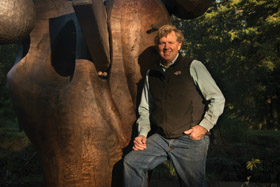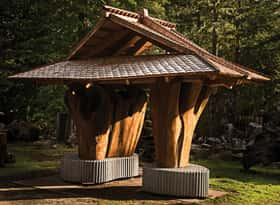 “People will never forget how you made them feel.” These wise words from Maya Angelou came to mind recently while visiting the new Outdoor Sculpture Garden and Art Walk at Santa Rosa’s Wells Fargo Center for the Arts.
“People will never forget how you made them feel.” These wise words from Maya Angelou came to mind recently while visiting the new Outdoor Sculpture Garden and Art Walk at Santa Rosa’s Wells Fargo Center for the Arts.Along a natural pathway between the Wells Fargo Center and the recently opened Sutter Hospital, the new sculpture garden is populated with more than a dozen giant sculptures for its inaugural exhibit, “Root 101.” Formed from ancient redwood stumps, the sculptures comprise an exhibit that’s simultaneously serene, whimsical and engaging.
So engaging in fact, both children and the “young at heart” will find themselves drawn to joyfully climb aboard. In one sculpture, climbing atop a ladder mounted on the inside of a tree trunk provides a view from tiny windows in the mushroom-shaped hammered copper top. Experiencing what the inside of a giant redwood tree feels and looks like is part of the appeal of the piece.
 It’s an exhibit that fosters a return to childlike appreciation and wonder, both for nature and for the imagination and artistry that created the sculpture. One tends not to forget such a moment.
It’s an exhibit that fosters a return to childlike appreciation and wonder, both for nature and for the imagination and artistry that created the sculpture. One tends not to forget such a moment.The man responsible for these moments—and this exhibit—is Bruce Johnson. In his late sixties, there’s a lighthearted quality about him; a twinkle in his eye and a spring in his step speak of the joyfully inviting ambience of this exhibit. And there’s also a calm, reflective aspect to his nature.
Born in Oregon, Johnson was raised in the Bay Area, he and his twin brother the youngest of four children. In high school in San Leandro, Johnson was an outstanding long distance runner, a sport that can foster fierce independence, as anyone who’s read the classic, The Loneliness of the Long Distance Runner will recall. He continues to enjoy solitary time in nature—biking 4,000 miles across the United States in 2009, for example.
Neither of his parents were artists, so he chose his own path in deciding to study art at UC Davis. He graduated with a teaching credential in 1972, but taught for only a year before being offered an opportunity to work in construction on the historic reconstruction of the Fort Ross Chapel.
Johnson was a part of the Bay Area’s Canyon Construction crew of the 1970s and ’80s, a crew made up of a group of friends, many of whom were degreed artists (some with advanced degrees). The company was known for its artistry in handmade houses and repurposed lumber, specifically redwood bridge timbers and other salvaged timber. Canyon’s Deva Rajan and Dean Pratt both influenced Johnson and his work.
Johnson also studied Japanese traditional arts and spent time in Japan, visiting famed sculptor/landscape architect/furniture designer, Isamu Noguchi.
But it was the Fort Ross Chapel project of 1973 that proved to be a turning point in his life. It brought Johnson out to Seaview on the Sonoma Coast, where he and his wife, Margie, eventually raised their two daughters and where they still live and work today. It also introduced him to the sacred in building.
Along with the whimsy in his art, there’s an undeniable spiritual element, a reverence and respect for nature. It’s clearly seen in this exhibit, in the unusual and beautiful Sea Ranch Chapel for which he was construction foreman and in his exquisite “Poetry House,” previously exhibited at Paradise Ridge Winery.
Johnson not only sees the beauty in wood, he also sees it in life and expresses his gratitude in many different ways. Now a grandfather, he’s created a piece in recognition of his fish biologist son-in-law’s work in creek restoration. Called “Bulltrout,” it’s a large half-trout/half-bull rocking horse with a saddle, kept at his home for his grandchildren to ride.
When asked how he might be described, he replies, “I’ve lived the life I wanted to live,” and his work—which resides in private and public collections all over the world including Taiwan, Spain and Italy—reflects it.



